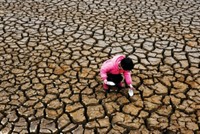Advertisement
Grab your lab coat. Let's get started
Welcome!
Welcome!
Create an account below to get 6 C&EN articles per month, receive newsletters and more - all free.
It seems this is your first time logging in online. Please enter the following information to continue.
As an ACS member you automatically get access to this site. All we need is few more details to create your reading experience.
Not you? Sign in with a different account.
Not you? Sign in with a different account.
ERROR 1
ERROR 1
ERROR 2
ERROR 2
ERROR 2
ERROR 2
ERROR 2
Password and Confirm password must match.
If you have an ACS member number, please enter it here so we can link this account to your membership. (optional)
ERROR 2
ACS values your privacy. By submitting your information, you are gaining access to C&EN and subscribing to our weekly newsletter. We use the information you provide to make your reading experience better, and we will never sell your data to third party members.
Environment
Global Warming Affirmations
Environment: Latest world report rests on stronger science, researchers say
by Jyllian Kemsley
October 3, 2013
| A version of this story appeared in
Volume 91, Issue 40

The world is warming and humans are the dominant cause, says the United Nations working group studying the physical science of climate change, confirming earlier assessments.
The full report of the UN’s Intergovernmental Panel on Climate Change (IPCC) Working Group I was released on Sept. 30. It largely verifies and refines previous climate analyses. The group notes that a better fundamental understanding of climate systems has boosted the confidence underlying its predictions and projections. These improvements arise from greater amounts of data available from continuing climate observations over time, enhanced climate models, and increases in computer-processing power—all of which advance sophistication of modeling.
“One can’t sell the computer power argument too short,” says Michael F. Wehner, a staff scientist at Lawrence Berkeley National Laboratory and a member of the IPCC working group. “We’re able to do runs at higher resolution and faster, and that means that you learn more, too.”
More of the models used in the current assessment include full carbon cycles, adds Linda O. Mearns, a senior scientist at the National Center for Atmospheric Research and another member of the IPCC assessment team. “That has given us a much better handle on how emissions would resolve into concentrations” of atmospheric pollutants, she says.
The report finds that the main driver of climate change is greenhouse gas emissions, principally of carbon dioxide. Without checks on greenhouse gas emissions, the global surface temperature will likely rise 2 °C by 2050 compared with 19th-century temperatures.
Extreme hot-weather events will increase in frequency, the report predicts. It notes that high-temperature events that currently occur once every 20 years will at least double in frequency by 2100 and in some places may occur annually. “Basically, rare temperature events become commonplace,” Wehner says.
Some enhanced climate models used in the climate-change assessment have begun to incorporate the effects of land use change. Since the last climate assessment in 2007, researchers have also been able to add ice sheet flow dynamics into modeling of sea level rise. IPCC projections indicate that the global mean sea level could rise by as much as 1 meter by 2100, which could cause devastating problems for some low-lying areas.
One subject of continued uncertainty in climate understanding is the effects of aerosols—which may reflect or absorb sunlight—and their influence on clouds. “That’s been a hole for a very long time, and it’s not an easy hole to fill,” Mearns says.
Reports by additional IPCC working groups focusing on the effects and options for mitigating climate change are slated to be released in the spring of 2014. Information in the reports will be used in negotiations for a climate-change treaty in 2015.




Join the conversation
Contact the reporter
Submit a Letter to the Editor for publication
Engage with us on Twitter